Performance of an Electrothermal MEMS Cantilever Resonator with Fano-Resonance Annoyance under Cigarette Smoke Exposure
Abstract
1. Introduction
2. Materials and Methods
2.1. Enhanced Parasitic Feedthrough Subtraction (PFS) Method
2.2. Measurement System for Resonant-Frequency Characterization and Tracking
3. Real-Time Cigarette Smoke Detection
4. Conclusions
Author Contributions
Funding
Institutional Review Board Statement
Informed Consent Statement
Data Availability Statement
Acknowledgments
Conflicts of Interest
References
- Elwenspoek, M.; Wiegerink, R. Mechanical Microsensors; Springer: Berlin/Heidelberg, Germany, 2001; ISBN 978-3-642-08706-6. [Google Scholar]
- Corigliano, A.; Ardito, R.; Comi, C.; Frangi, A.A.; Ghisi, A.; Mariani, S. Microsystems and Mechanics. Procedia IUTAM 2014, 10, 138–160. [Google Scholar] [CrossRef][Green Version]
- Wasisto, H.S.; Uhde, E.; Peiner, E. Enhanced performance of pocket-sized nanoparticle exposure monitor for healthy indoor environment. Build. Environ. 2016, 95, 13–20. [Google Scholar] [CrossRef]
- Xu, J.; Bertke, M.; Wasisto, H.S.; Peiner, E. Piezoresistive microcantilevers for humidity sensing. J. Micromech. Microeng. 2019, 29, 053003. [Google Scholar] [CrossRef]
- Yu, H.; Li, X.; Gan, X.; Liu, Y.; Liu, X.; Xu, P.; Li, J.; Liu, M. Resonant-cantilever bio/chemical sensors with an integrated heater for both resonance exciting optimization and sensing repeatability enhancement. J. Micromech. Microeng. 2009, 19, 45023. [Google Scholar] [CrossRef]
- Beardslee, L.A.; Addous, A.M.; Heinrich, S.; Josse, F.; Dufour, I.; Brand, O. Thermal Excitation and Piezoresistive Detection of Cantilever In-Plane Resonance Modes for Sensing Applications. J. Microelectromech. Syst. 2010, 19, 1015–1017. [Google Scholar] [CrossRef]
- Tao, Y.; Li, X.; Xu, T.; Yu, H.; Xu, P.; Xiong, B.; Wei, C. Resonant cantilever sensors operated in a high-Q in-plane mode for real-time bio/chemical detection in liquids. Sens. Actuators B Chem. 2011, 157, 606–614. [Google Scholar] [CrossRef]
- Rahafrooz, A.; Pourkamali, S. Fabrication and characterization of thermally actuated micromechanical resonators for airborne particle mass sensing: I. Resonator design and modeling. J. Micromech. Microeng. 2010, 20, 125018. [Google Scholar] [CrossRef]
- Shi, H.; Fan, S.; Zhang, Y.; Sun, J. Design and optimization based on uncertainty analysis in electro-thermal excited MEMS resonant sensor. Microsyst. Technol. 2014, 21, 757–771. [Google Scholar] [CrossRef]
- Potekhina, A.; Wang, C. Review of Electrothermal Actuators and Applications. Actuators 2019, 8, 69. [Google Scholar] [CrossRef]
- Chiang, C.-H.; Chou, M.-C.; Hsieh, P.-H.; Lu, M.S.-C. Design and Characterization of a CMOS MEMS Capacitive Oscillator for Resonant Sensing in Liquids. IEEE Sens. J. 2015, 16, 1136–1142. [Google Scholar] [CrossRef]
- Ghosh, S.; Lee, J.E.-Y. Piezoelectric-on-Silicon MEMS Lorentz Force Lateral Field Magnetometers. IEEE Trans. Ultrason. Ferroelectr. Freq. Control. 2019, 66, 965–974. [Google Scholar] [CrossRef]
- Holmes, C.; Jantzen, A.; Gray, A.C.; Carpenter, L.G.; Gow, P.C.; Lynch, S.G.; Gates, J.C.; Smith, P.G.R. Integrated Optical Fiber-Tip Cantilevers. IEEE Sens. J. 2017, 17, 6960–6965. [Google Scholar] [CrossRef]
- Panas, R.M.; Cullinan, M.A.; Culpepper, M.L. Design of piezoresistive-based MEMS sensor systems for precision microsystems. Precis. Eng. 2012, 36, 44–54. [Google Scholar] [CrossRef]
- Ansari, M.Z.; Cho, C.; Choi, W.; Lee, M.; Lee, S.; Kim, J. Improving sensitivity of piezoresistive microcantilever biosensors using stress concentration region designs. J. Phys. D Appl. Phys. 2013, 46, 505501. [Google Scholar] [CrossRef]
- Nyang’Au, W.O.; Setiono, A.; Bertke, M.; Bosse, H.; Peiner, E.; Au, N. Cantilever-Droplet-Based Sensing of Magnetic Particle Concentrations in Liquids. Sensors 2019, 19, 4758. [Google Scholar] [CrossRef]
- Wasisto, H.S.; Merzsch, S.; Uhde, E.; Waag, A.; Peiner, E. Handheld personal airborne nanoparticle detector based on microelectromechanical silicon resonant cantilever. Microelectron. Eng. 2015, 145, 96–103. [Google Scholar] [CrossRef]
- Sahu, S.; Tiwari, M.; Bhangare, R.; Pandit, G. Particle Size Distribution of Mainstream and Exhaled Cigarette Smoke and Predictive Deposition in Human Respiratory Tract. Aerosol Air Qual. Res. 2013, 13, 324–332. [Google Scholar] [CrossRef]
- Keith, C.; Derrick, J. Measurement of the particle size distribution and concentration of cigarette smoke by the “conifuge”. J. Colloid Sci. 1960, 15, 340–356. [Google Scholar] [CrossRef]
- Setiono, A.; Fahrbach, M.; Xu, J.; Bertke, M.; Nyang’Au, W.O.; Hamdana, G.; Wasisto, H.S.; Peiner, E. Phase optimization of thermally actuated piezoresistive resonant MEMS cantilever sensors. J. Sens. Sens. Syst. 2019, 8, 37–48. [Google Scholar] [CrossRef]
- Schuchinsky, A.; Steer, M. Dynamics of resistive electro-thermal nonlinearity. In Proceedings of the 2017 IEEE MTT-S International Conference on Numerical Electromagnetic and Multiphysics Modeling and Optimization for RF, Microwave, and Terahertz Applications (NEMO), Seville, Spain, 17–19 May 2017. [Google Scholar]
- Miroshnichenko, A.E.; Flach, S.; Kivshar, Y.S. Fano resonances in nanoscale structures. Rev. Mod. Phys. 2010, 82, 2257–2298. [Google Scholar] [CrossRef]
- Xu, Y.; Lee, J.E.-Y. Single-Device and On-Chip Feedthrough Cancellation for Hybrid MEMS Resonators. IEEE Trans. Ind. Electron. 2011, 59, 4930–4937. [Google Scholar] [CrossRef]
- Sell, J.; Niedermayer, A.; Jakoby, B. Digital phase-locked loop circuit for driving resonant sensors. Procedia Eng. 2010, 5, 204–207. [Google Scholar] [CrossRef][Green Version]
- Wasisto, H.S.; Zhang, Q.; Merzsch, S.; Waag, A.; Peiner, E. A phase-locked loop frequency tracking system for portable microelectromechanical piezoresistive cantilever mass sensors. Microsyst. Technol. 2014, 20, 559–569. [Google Scholar] [CrossRef]
- Toledo, J.; Ruiz-Díez, V.; Bertke, M.; Wasisto, H.S.; Peiner, E.; Sánchez-Rojas, J.L. Piezoelectric MEMS Resonators for Cigarette Particle Detection. Micromachines 2019, 10, 145. [Google Scholar] [CrossRef]
- Badarlis, A.; Pfau, A.; Kalfas, A. Measurement and Evaluation of the Gas Density and Viscosity of Pure Gases and Mixtures Using a Micro-Cantilever Beam. Sensors 2015, 15, 24318–24342. [Google Scholar] [CrossRef]
- Franken, R.; Maggos, T.; Stamatelopoulou, A.; Loh, M.; Kuijpers, E.; Bartzis, J.; Steinle, S.; Cherrie, J.W.; Pronk, A. Comparison of methods for converting Dylos particle number concentrations to PM2.5 mass concentrations. Indoor Air 2019, 29, 450–459. [Google Scholar] [CrossRef]
- Unger, R.L. Compact, Low Cost Particle Sensor. U.S. Patent No. 8,009,290, 30 August 2011. [Google Scholar]
- Wasisto, H.S.; Merzsch, S.; Waag, A.; Uhde, E.; Salthammer, T.; Peiner, E. Portable cantilever-based airborne nanoparticle detector. Sens. Actuators B Chem. 2013, 187, 118–127. [Google Scholar] [CrossRef]
- Wasisto, H.S.; Merzsch, S.; Waag, A.; Uhde, E.; Salthammer, T.; Peiner, E. Airborne engineered nanoparticle mass sensor based on a silicon resonant cantilever. Sens. Actuators B Chem. 2013, 180, 77–89. [Google Scholar] [CrossRef]
- Wasisto, H.S. Direct-Reading Personal Airborne Nanoparticle Detector Based on Micromechanical Silicon Cantilever Resonators; Verlag Dr. Hut: München, Germany, 2014; ISBN 9783843916806. [Google Scholar]
- Tóthová, J.; Šoltýs, A.; Lisý, V. Brownian motion in a bath responding to external electric fields. J. Mol. Liq. 2020, 317, 113920. [Google Scholar] [CrossRef]
- Krinke, T.J.; Deppert, K.; Magnusson, M.; Schmidt, F.; Fissan, H. Microscopic aspects of the deposition of nanoparticles from the gas phase. J. Aerosol Sci. 2002, 33, 1341–1359. [Google Scholar] [CrossRef]
- Bertke, M.; Xu, J.; Setiono, A.; Kirsch, I.; Uhde, E.; Peiner, E. Fabrication of a microcantilever-based aerosol detector with integrated electrostatic on-chip ultrafine particle separation and collection. J. Micromech. Microeng. 2019, 30, 014001. [Google Scholar] [CrossRef]
- He, J.H.; Li, Y.F. High sensitivity piezoresistive cantilever sensor for biomolecular detection. J. Phys. Conf. Ser. 2006, 34, 429–435. [Google Scholar] [CrossRef]
- Ryu, W.; Chung, Y.-C.; Choi, D.-K.; Yoon, C.; Kim, C.; Kim, Y.-H. Computer simulation of the resonance characteristics and the sensitivity of cantilever-shaped Al/PZT/RuO2 biosensor. Sens. Actuators B Chem. 2004, 97, 98–102. [Google Scholar] [CrossRef]
- Setiono, A.; Nyang’Au, W.O.; Fahrbach, M.; Xu, J.; Bertke, M.; Wasisto, H.S.; Peiner, E. Improvement of frequency responses of an in-plane electro-thermal cantilever sensor for real-time measurement. J. Micromech. Microeng. 2019, 29, 124006. [Google Scholar] [CrossRef]
- Wasisto, H.S.; Merzsch, S.; Waag, A.; Kirsch, I.; Uhde, E.; Salthammer, T.; Peiner, E. Determination of exposure to engineered carbon nanoparticles using a self-sensing piezoresistive silicon cantilever sensor. Microsyst. Technol. 2012, 18, 905–915. [Google Scholar] [CrossRef]
- Johnson, T.; Olfert, J.; Cabot, R.; Treacy, C.; Yurteri, C.U.; Dickens, C.; McAughey, J.; Symonds, J.P. Steady-state measurement of the effective particle density of cigarette smoke. J. Aerosol Sci. 2014, 75, 9–16. [Google Scholar] [CrossRef]
- Arling, J.; O’Connor, K.; Mercieca, M. Air Quality Sensor Network for Philadelphia: Data Validation. Available online: aqicn.org/data/dylos/Air-Quality-Sensor-Network-for-Philadelphia.pdf (accessed on 12 May 2021).
- Norman, V.; Keith, C.H. Charged particles in cigarette smoke. Tob. Sci. 1965, 16, 75–79. [Google Scholar]
- Liu, C.; Feng, S.; Van Heemst, J.; McAdam, K.G. New insights into the formation of volatile compounds in mainstream cigarette smoke. Anal. Bioanal. Chem. 2010, 396, 1817–1830. [Google Scholar] [CrossRef]
- Cattaneo, V.; Cetta, G.; Rota, C.; Vezzoni, F.; Rota, M.; Gallanti, A.; Boratto, R.; Poggi, P. Volatile Components of Cigarette Smoke: Effect of Acrolein and Acetaldehyde on Human Gingival Fibroblasts In Vitro. J. Periodontol. 2000, 71, 425–432. [Google Scholar] [CrossRef]
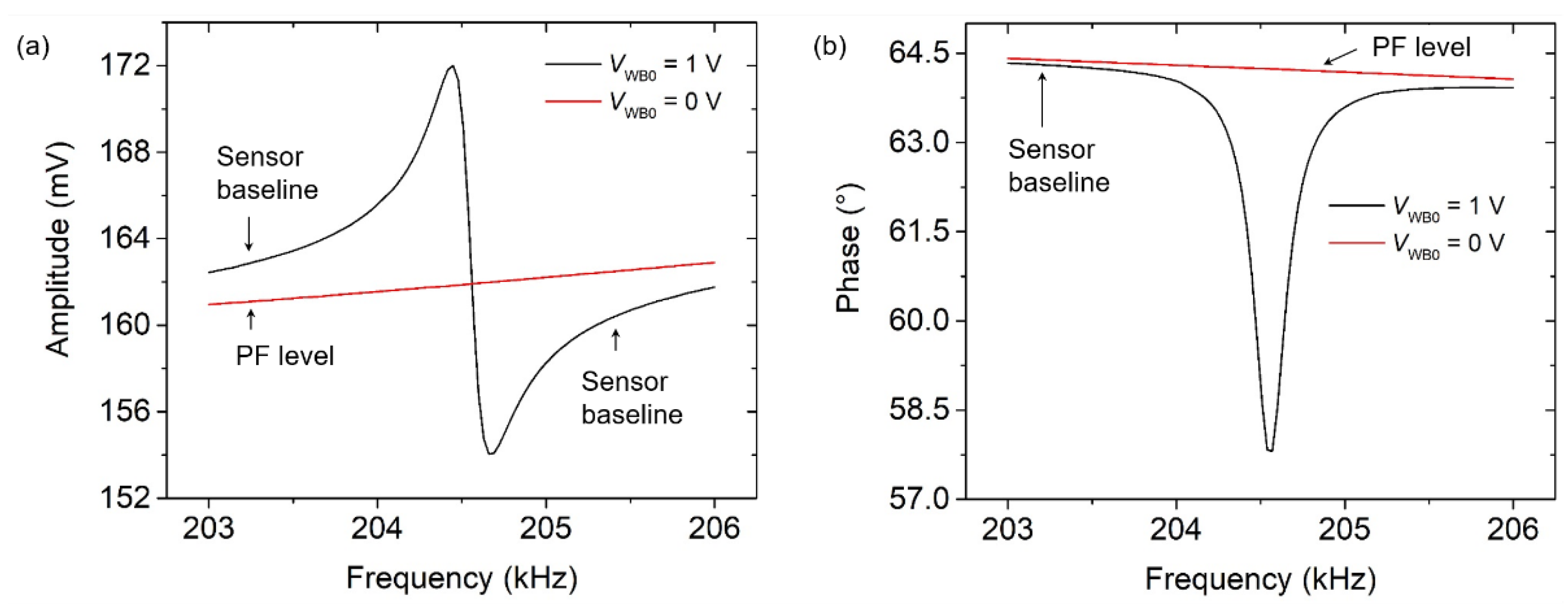
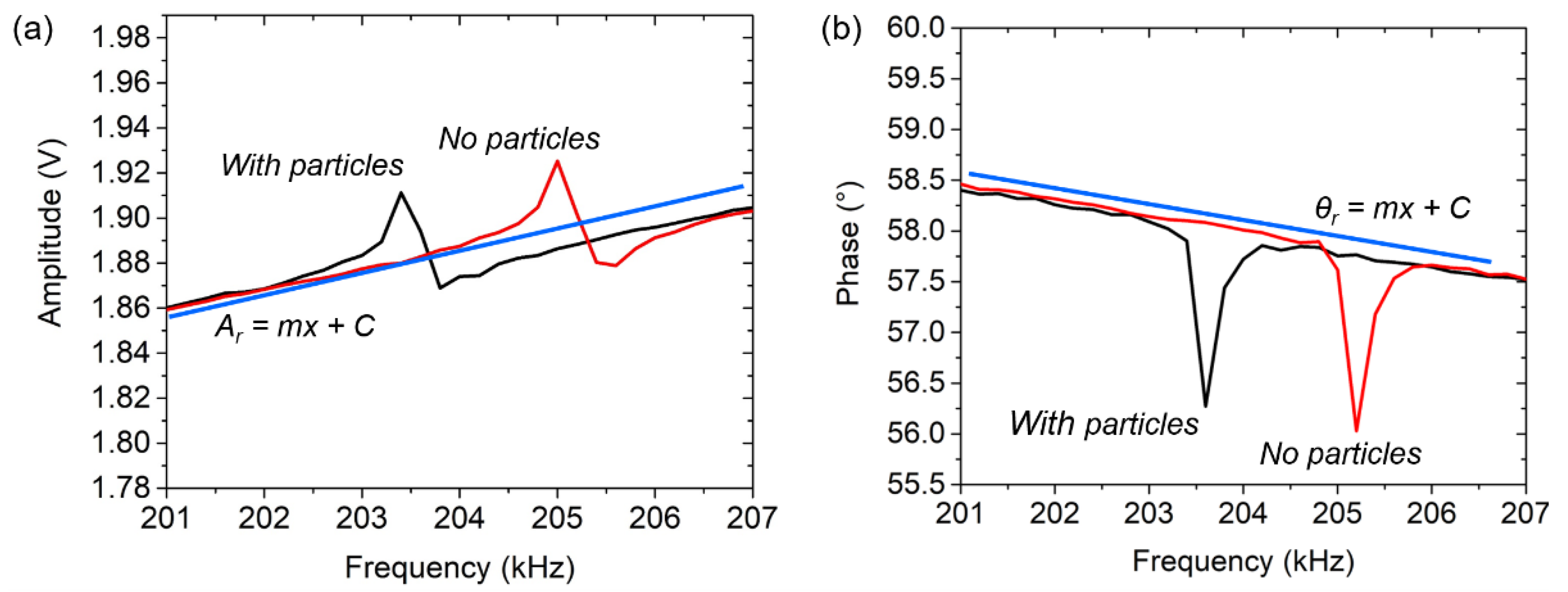
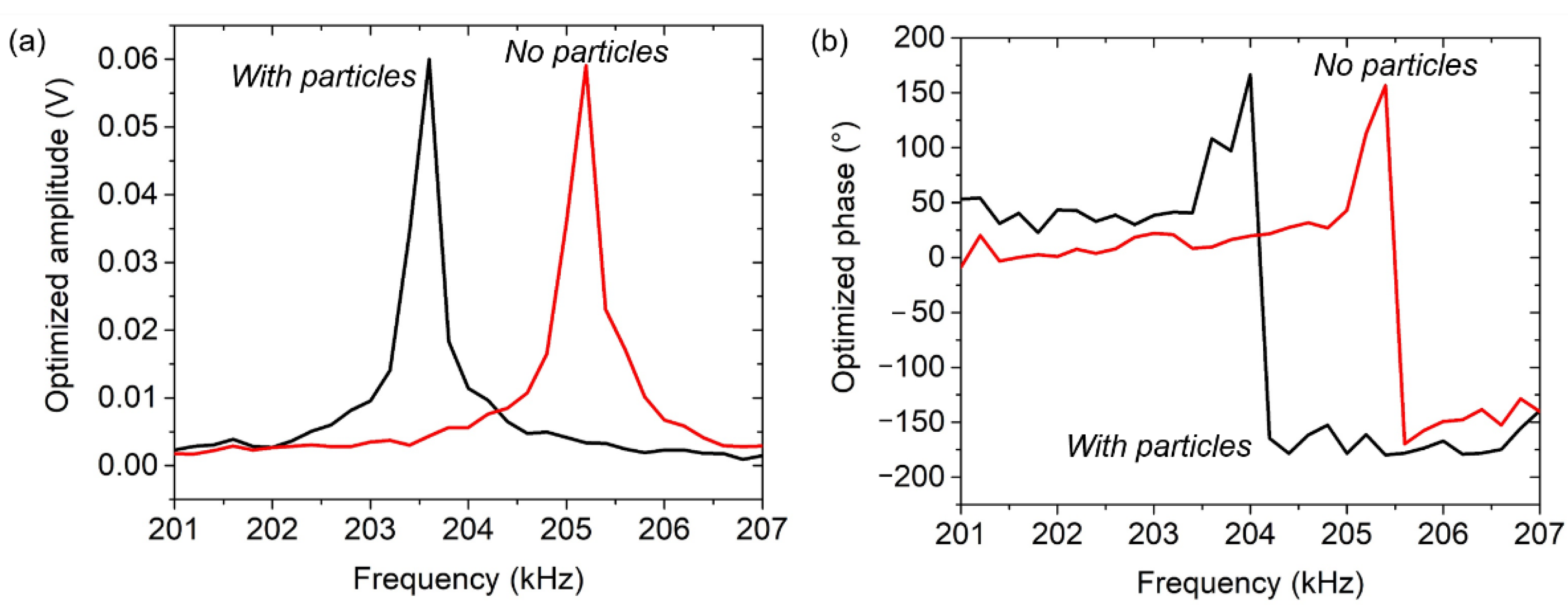
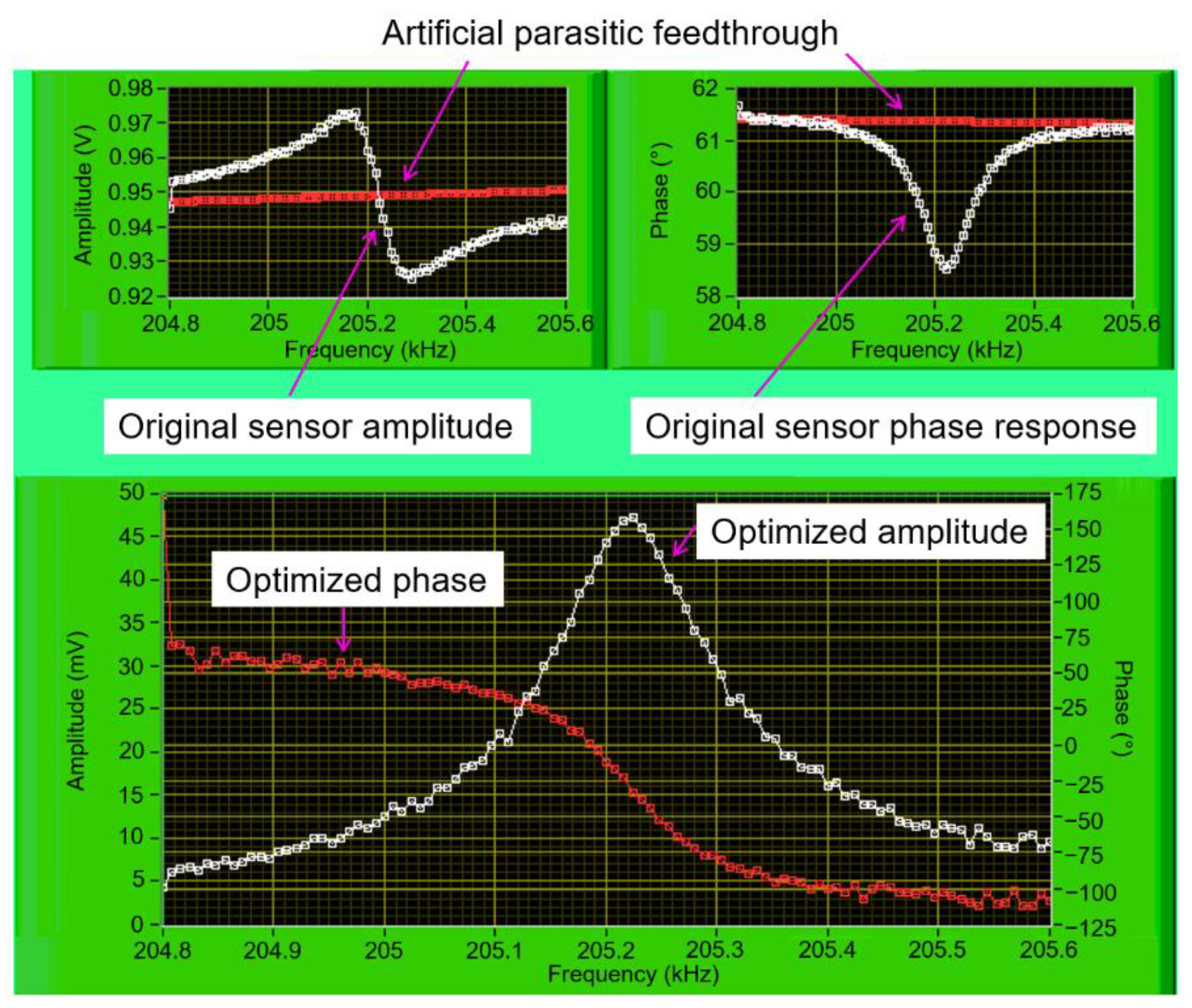
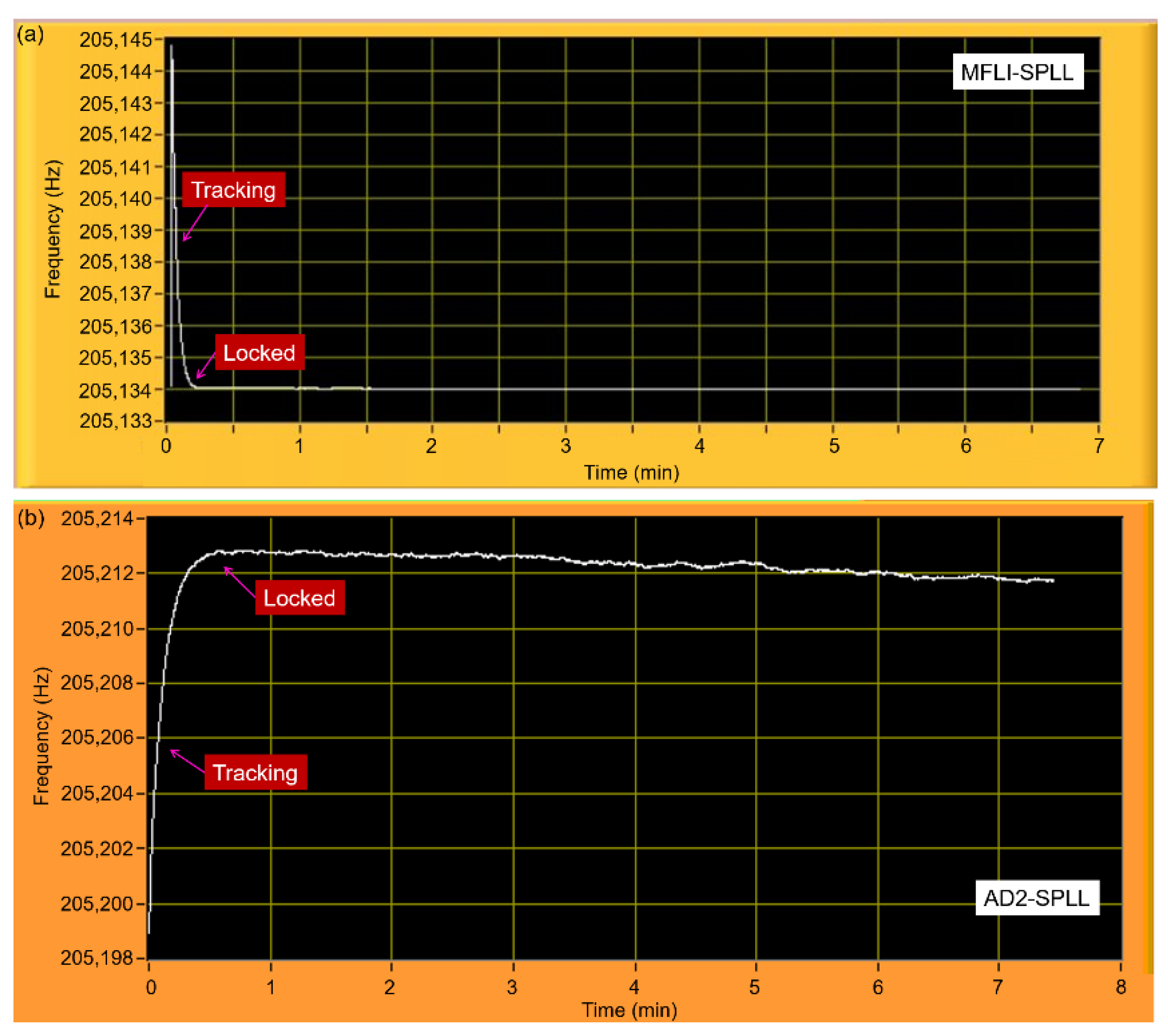
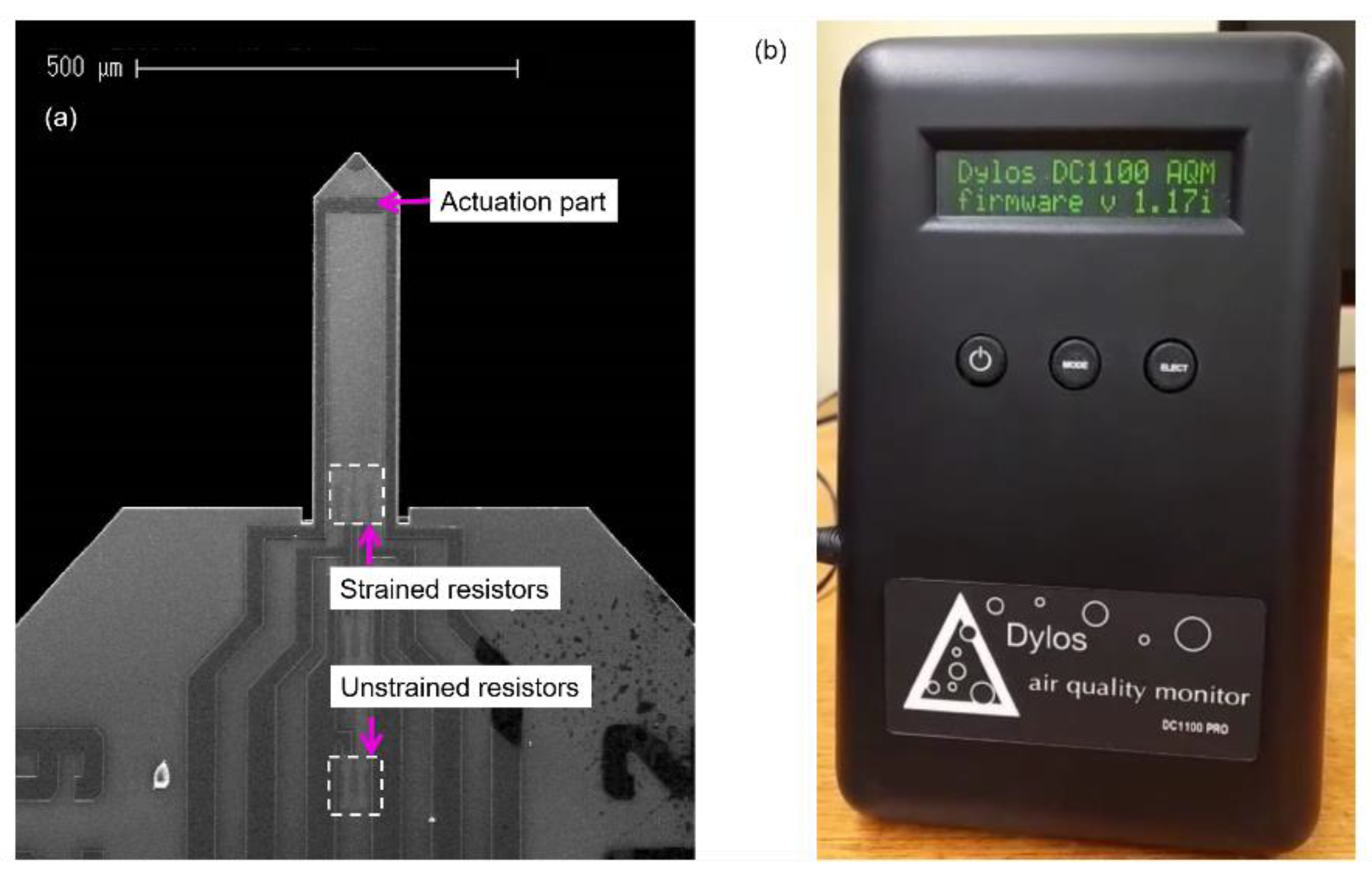
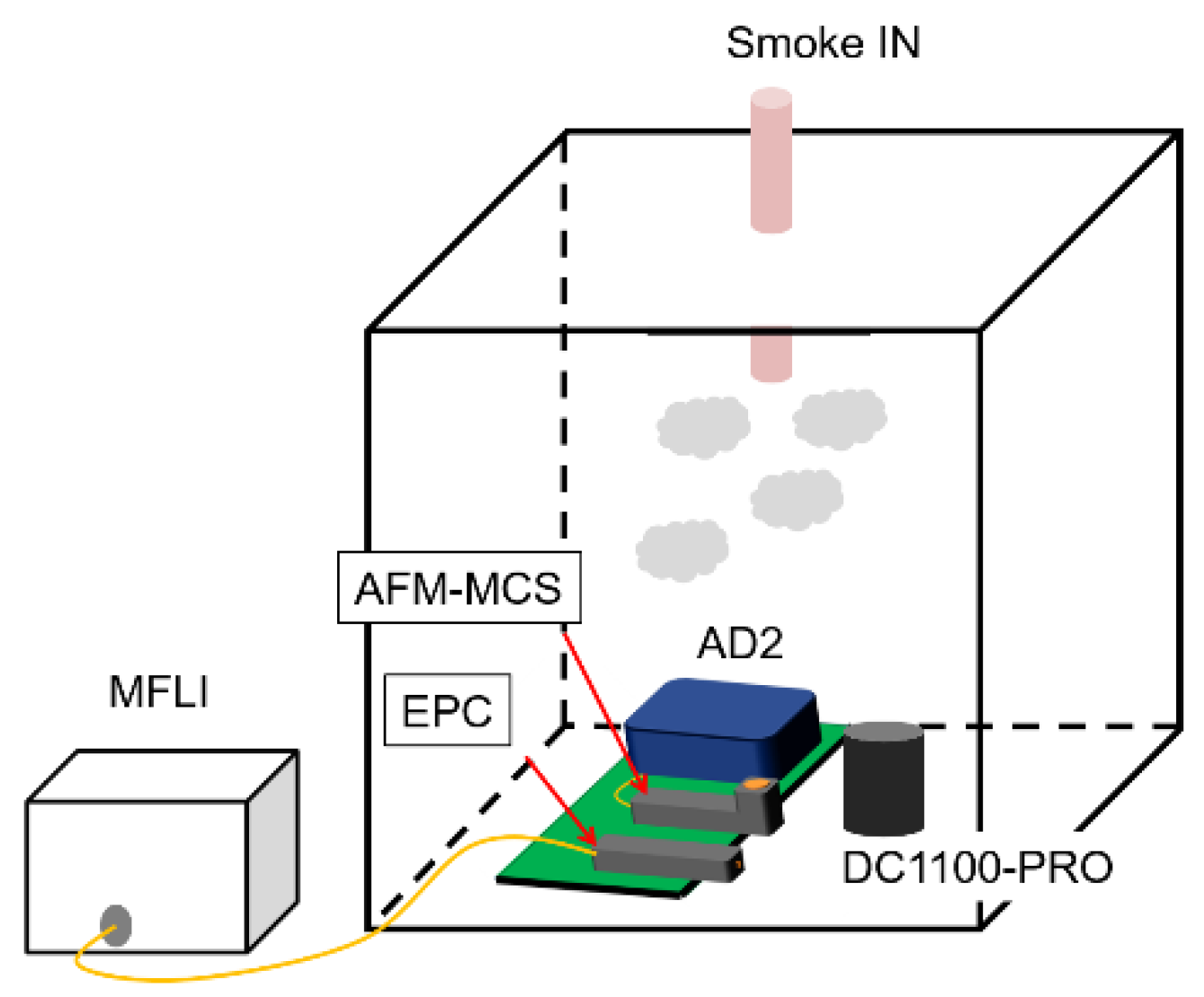
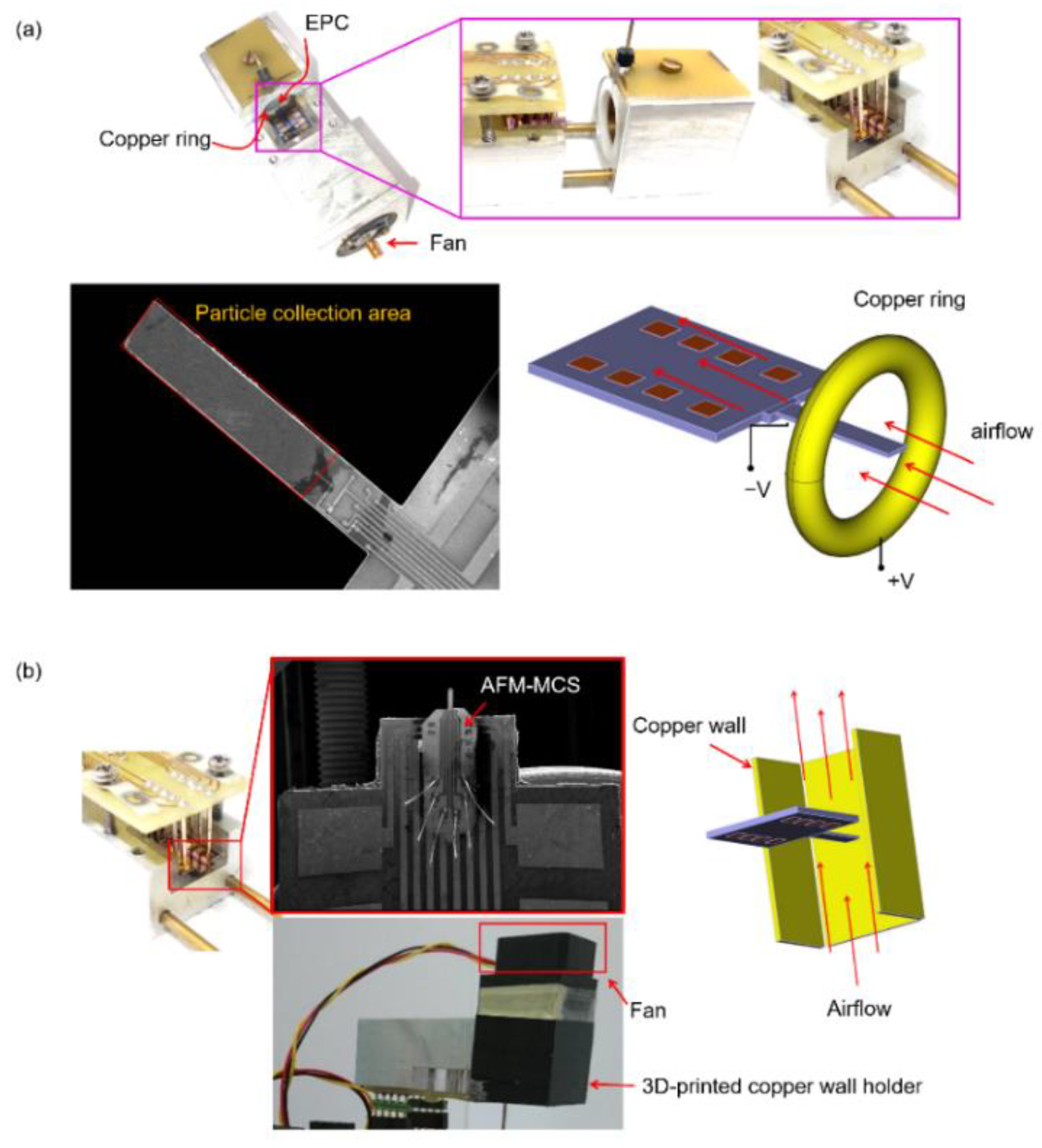
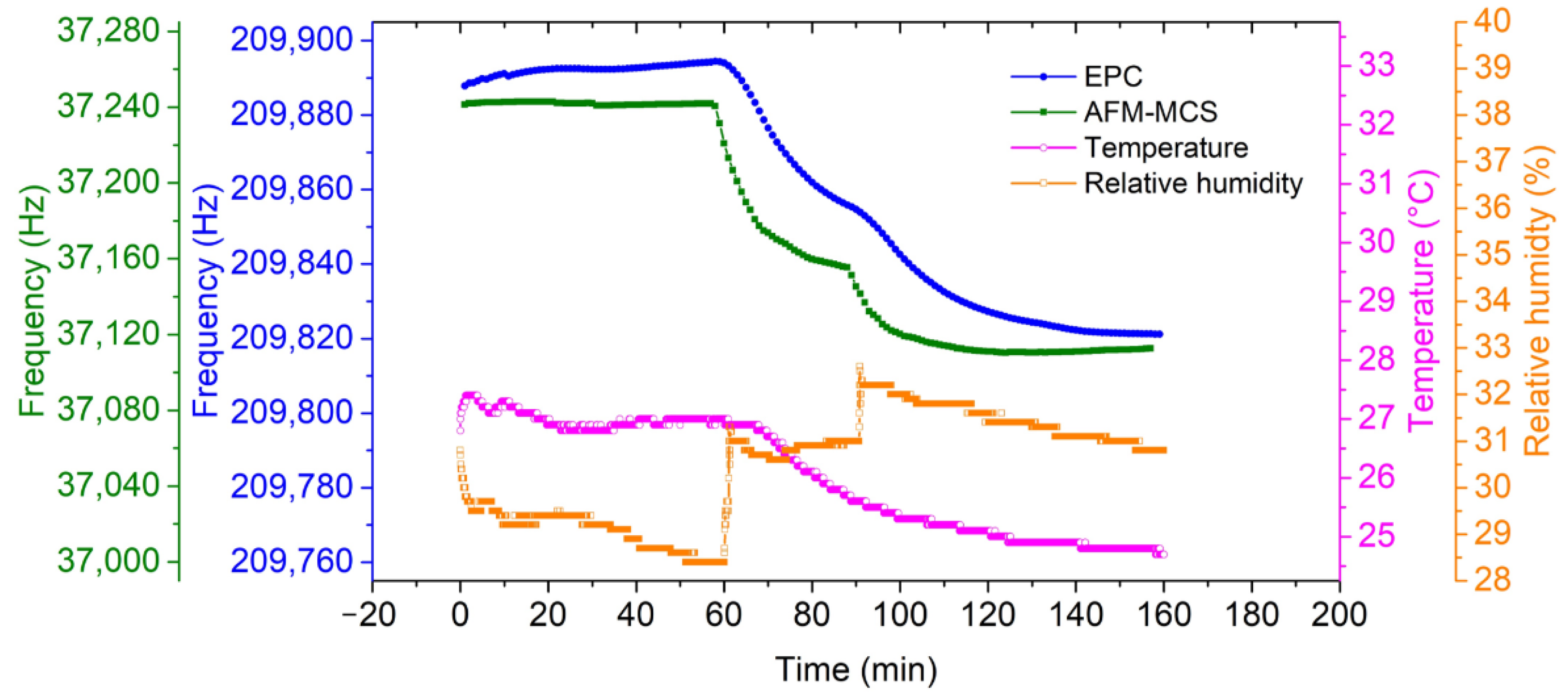
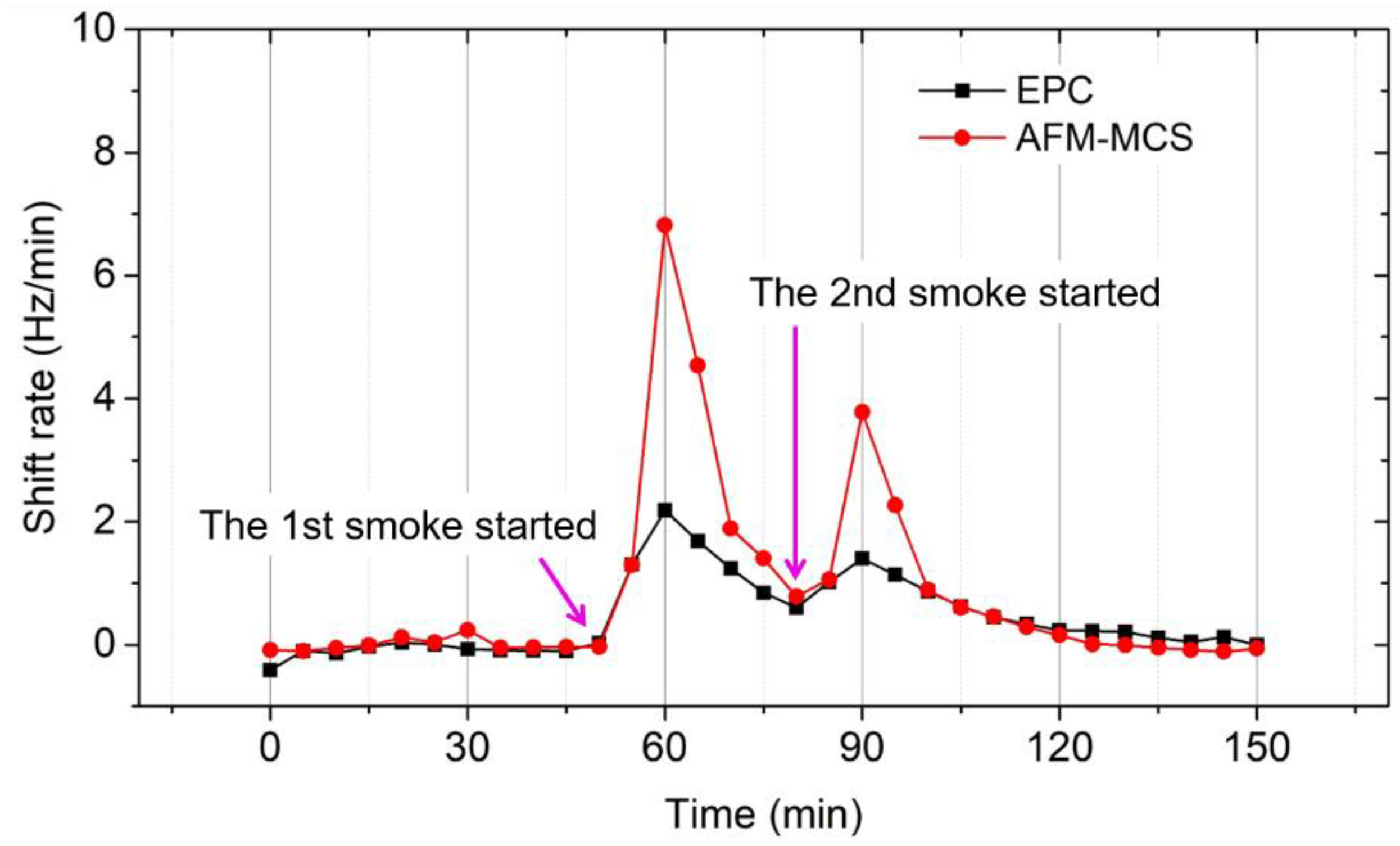
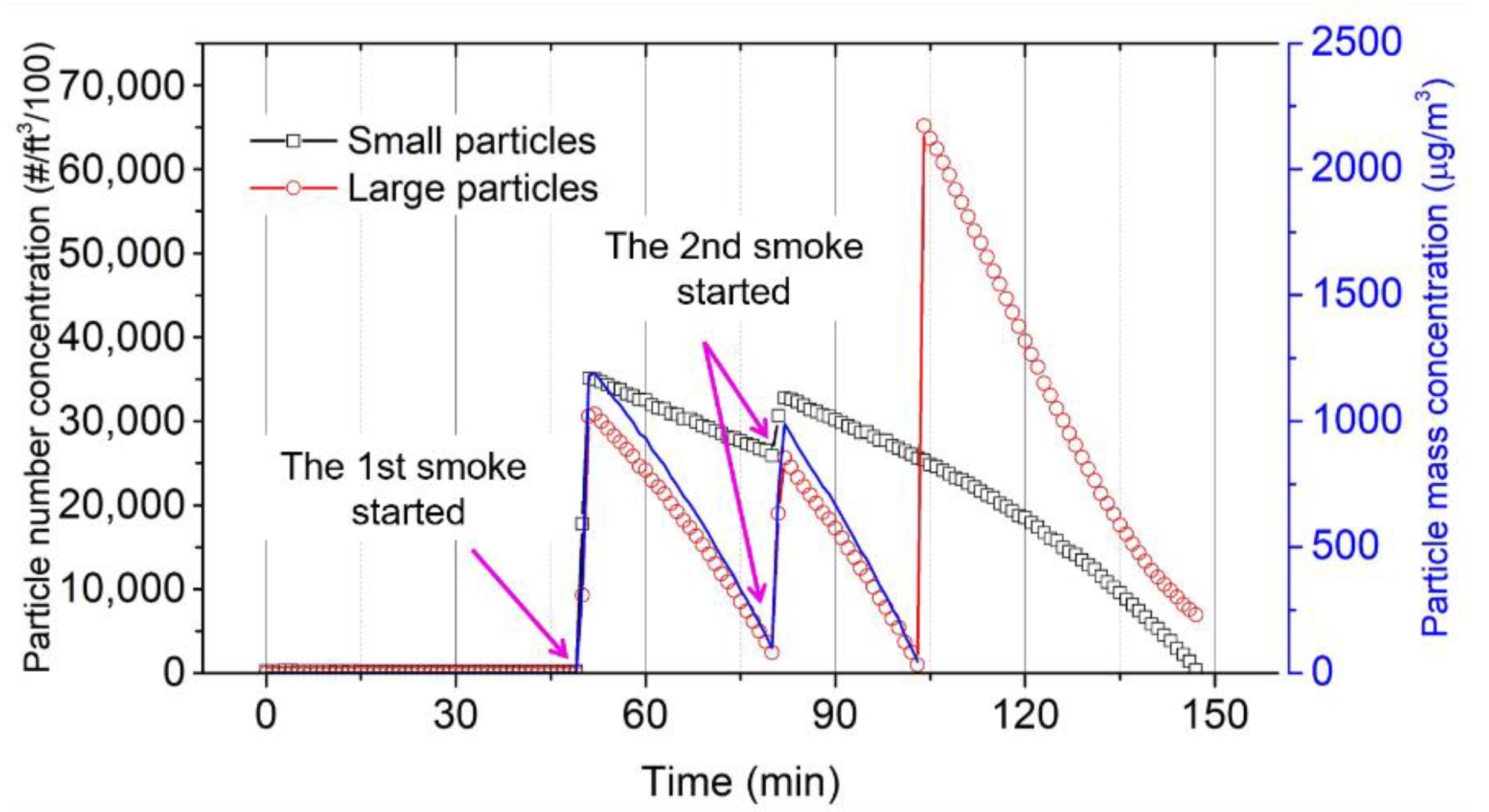

Publisher’s Note: MDPI stays neutral with regard to jurisdictional claims in published maps and institutional affiliations. |
© 2021 by the authors. Licensee MDPI, Basel, Switzerland. This article is an open access article distributed under the terms and conditions of the Creative Commons Attribution (CC BY) license (https://creativecommons.org/licenses/by/4.0/).
Share and Cite
Setiono, A.; Fahrbach, M.; Deutschinger, A.; Fantner, E.J.; Schwalb, C.H.; Syamsu, I.; Wasisto, H.S.; Peiner, E. Performance of an Electrothermal MEMS Cantilever Resonator with Fano-Resonance Annoyance under Cigarette Smoke Exposure. Sensors 2021, 21, 4088. https://doi.org/10.3390/s21124088
Setiono A, Fahrbach M, Deutschinger A, Fantner EJ, Schwalb CH, Syamsu I, Wasisto HS, Peiner E. Performance of an Electrothermal MEMS Cantilever Resonator with Fano-Resonance Annoyance under Cigarette Smoke Exposure. Sensors. 2021; 21(12):4088. https://doi.org/10.3390/s21124088
Chicago/Turabian StyleSetiono, Andi, Michael Fahrbach, Alexander Deutschinger, Ernest J. Fantner, Christian H. Schwalb, Iqbal Syamsu, Hutomo Suryo Wasisto, and Erwin Peiner. 2021. "Performance of an Electrothermal MEMS Cantilever Resonator with Fano-Resonance Annoyance under Cigarette Smoke Exposure" Sensors 21, no. 12: 4088. https://doi.org/10.3390/s21124088
APA StyleSetiono, A., Fahrbach, M., Deutschinger, A., Fantner, E. J., Schwalb, C. H., Syamsu, I., Wasisto, H. S., & Peiner, E. (2021). Performance of an Electrothermal MEMS Cantilever Resonator with Fano-Resonance Annoyance under Cigarette Smoke Exposure. Sensors, 21(12), 4088. https://doi.org/10.3390/s21124088






